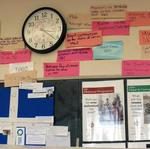By: Joanna Zapior
The first semester with the new GLC20 curriculum is wrapping up. It includes a large financial literacy component (Strand C2). Rapport has talked about teaching financial literacy with:
- Joanna Zapior, co-founder of FinStart, a new financial literacy resource for students and teachers.
- Katherine Welsh, teacher at Chelmsford Valley District Composite School who has started teaching a financial literacy lesson once a week during her GLC20 course this semester and decided to give FinStart a try.
- Leanne Kirsch, occasional teacher in the Toronto District School Board who piloted FinStart in the classroom this October as a component of GLC20.
Why is achieving financial literacy so challenging?
JZ: There are several reasons.
- Money is both abstract and emotional. It can be difficult to talk about, even amongst family and friends.
- The scope of what is considered financial literacy is well defined but vast. Many skills need to be mastered: banking and payments, borrowing, saving and investing, choosing insurance, filing taxes and using registered accounts, budgeting and multi-year financial planning (like funding post-secondary education).
- Personal finance is both a way of thinking and a set of practical skills. One needs to learn how to make astute financial decisions as well as how to effectively gather information about financial products. Teaching personal finance may be more like teaching culinary arts, shop, or how to fly an airplane than teaching math or English.
- To be useful in real life, financial literacy needs to incorporate knowledge of real-life financial products. There will be some financial jargon to deal with, product advertising to drill through, and a fast rate of change in products and services to adapt to.
| The curriculum defines financial literacy as competence and confidence. We couldn’t agree more. ‘Competence’ in personal finance means ‘the ability to get it done’. And that competence breeds confidence. |
Which elements of FinStart resonated well with your students?
KW: I found that the case studies included in the FinStart Course Binder worked well in my class. Students were engaged in discussions and made some good financial decisions.
JZ: We observed a few groups of students using an earlier version of FinStart in the classroom. They gravitated towards two elements:
- Interactive quizzes. In one class, students went directly to the quizzes and spent most of their time there.
- Research tables. Those are real offers from real banks. Students recognized some of them. It became quite personal and emotional: “I have an account with that bank ”. Perhaps that is the first step in the process of getting to ‘own’ your financial decisions.
In response, we’ve added a new feature. Students can familiarize themselves with each new topic through a short and somewhat zany story. As they click through to follow the main characters, students are asked to help the characters in the story solve various financial problems. The interactions are formulated as multiple choice questions. Both right and wrong answers come with short explanations. Students can reach to the material on the website for more information.
KW: I agree with the comment on the research tables. A couple students in my class even mentioned that they might have to switch banks after looking at the information posted on the website.
What FinStart features are useful for you as teachers?
KW: Overall the information is very detailed – I appreciate that. I liked in the lesson about Income Tax that there were questions guiding the students through the material online. I would appreciate more lessons like that as it ensures that students are going through the material and making notes. Otherwise I would feel compelled to make my own or go through it with the students (my preference is to have students become familiar with the site on their own as they would be more likely to return to it later in life when they need information).
LK: I like the concept – it has potential to be very useful to teachers as a financial literacy hub. It’s built and maintained by financial professionals who invite us, teachers, to contribute our experience and ideas about teaching. To me, the key thing is to find a hook. We need to share ideas in a teachers’ portal about how to:
- activate the classroom;
- address the emotional aspect – lack of knowledge creates anxiety and stress;
- explain the context of banking – it’s a for-profit business and you need to learn to be an informed consumer;
- engage – a broader range of activities, games, competitions.
FinStart is complementary to other resources – very hands on, includes practical checklists related to real-life financial products and services. As a true hub for teachers, it should incorporate links to other useful resources. I hear it’s in the works!
How has feedback been so far?
JZ: Very helpful and very concrete. We’re in touch with almost one hundred teachers across the province who are using the platform and our teaching resources.
Here’s a sample of what we’re working on based on the early feedback (in addition to the teachers’ portal Leanne mentioned, and Katherine’s request for more handouts to help guide the students through the content):
- Interactive features of the website;
- Additional classroom activities beyond GLC20 – English, math, business / economics);
- On ramps for ESL students and for struggling students to help them catch up to the core material;
- Current economic commentary integrated with the platform;
- French language version.
For access to teaching resources, contact FinStart at https://www.finstart.ca/for-teachers.html. Teachers are welcome to use the GLC20 course binder which includes: lesson plans, activities, handouts, case studies, and answer keys.
FinStart was created by a small group of financial professionals with many years of experience working in the sector. They were inspired by their own children, family, friends, and – at work – interns and new graduates, who made them realize there is a need for basic personal finance information, presented in an easy and engaging way. FinStart is a growing community of users – young adults, teachers, parents, professors, financial institutions and government.
Find out more about FinStart at https://www.finstart.ca/about.html.
Katherine Welsh been teaching for 15 years in the Rainbow District School Board at Chelmsford Valley District Composite School, mostly in math, physics and special education. She acted as Program Leader of Special Education, as well as Numeracy and Science.
Leanne Kirsch has been an occasional teacher with the TDSB for 10 years. She specializes in applied level classrooms and has taught in a variety of settings. Previous to bring s teacher, Leanne worked in financial services for 10 years. She is passionate about financial literacy education as an empowering skill set.
Joanna Zapior, co-founder of FinStart, has over 25 years of experience in financial services. She was a managing director at CIBC, specializing in investment research. She currently advises the Board of Trustees of Hospitals of Ontario Pension Plan.


